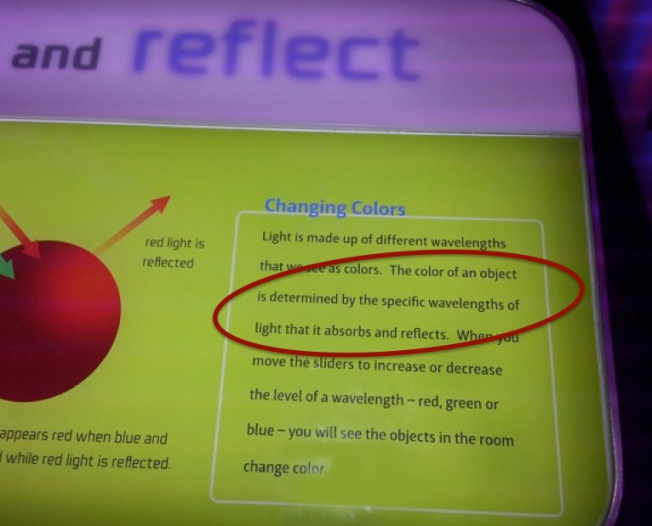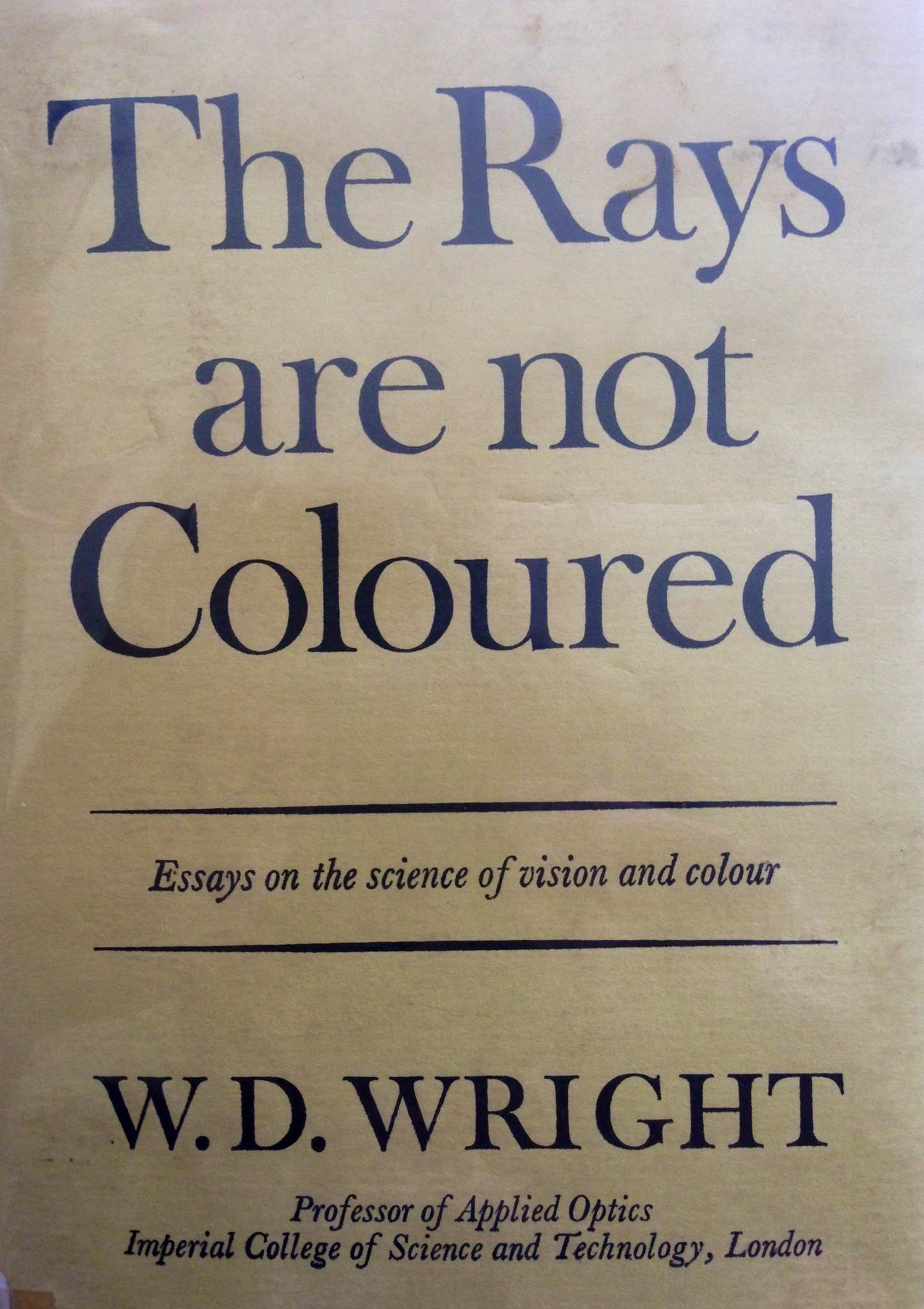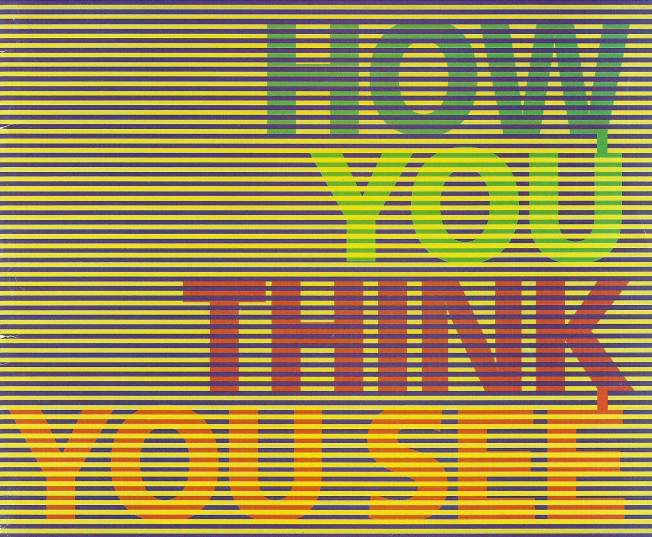Museum of Science and Industry, Chicago: Review

According to the Museum of Science and Industry (Chicago, IL) “the color of an object is determined by the specific wavelengths of lights that it absorbs and reflects” but THIS IS NOT TRUE. This wrong definition is presented in the Color Booth and situated in the Science Storm Exhibition. Here are some explanations about why color is NOT determined by the specific wavelengths of lights that it absorbs and reflects:
“Many people believe that color is a defining and essential property of objects, one depending entirely on the specific wavelengths of light reflected from them. But this belief is mistaken. Color is a sensation created in the brain. If the colors we perceived depended only on the wavelength of reflected light, an object’s color would appear to change dramatically with variations in illumination through- out the day and in shadows. Instead patterns of activity in the brain render an object’s color relatively stable despite changes in its environment.” – by John Werner, Ph.D.: UC Davis, Center for Neuroscience.
“While color of an isolated light is closely related to the light’s physical properties — its energy and wavelengths — this is a misleading fact for understanding normal viewing. Color is not in light. What we see depends directly on a pattern of neural responses, not on the wavelength or energy of light that enters the eye. The simple relation between a physical stimulus and how we perceive it breaks down when the light is part of a complex scene. In natural viewing, the whole visual stimulus is a patchwork of different lights from many objects. The neural response to a particular light, and therefore our perception of it, is affected by the context of the other lights also in view.” – by Steve Shevell, Ph.D.: University of Chicago, Institute for Mind and Biology.
“Color is often thought to be a quality of light but this is not so. For example, the expression the ocean is blue uses a perceptual experience of blueness to describe the physical light. Color itself is not in the light. Color is a perceptual phenomenon determined by neural processes in the brain. The region of the electromagnetic spectrum that is visible to humans is from about 400 nm to 700 nm, but no wavelength is endowed with a color. Instead, a particular wavelength, say a wavelength near 470 nm or 580 nm, is perceived as blue or yellow, respectively, only because these wavelengths stimulate the photoreceptors in the human eye that are responsible for the transduction of physical light into neural responses. Those neural responses go through a series of processing stages in the brain. The experience of blue or yellow, as well as all other colors, is a mental construction. The experience of a color is like the understanding of language. There is no meaning in the physical sound (the brain must interpret it) just as there is no blue or yellow in the wavelengths of light. Color is a percept that humans are able to experience through sensory neural processes.” – by Claudia Feitosa-Santana, Ph.D.: Roosevelt University, Psychology Department.
This is very old news:
Isaac Newton (1642, 1727) brilliantly wrote about in his book “Opticks“, first published in 1704: “And if at any time I speak of light and rays as coloured or endowed with colours, I would be understood to speak not philosophically and properly, but grossly, and accordingly to such conceptions as vulgar people in seeing all these experiments would be apt to frame. For the rays to speak properly are not coloured. In them there is nothing else then a certain power and disposition to stir up a sensation of this or that colour.”
Later, W. D. Wright was inspired by Newton’s words and published a book named “The Rays are not Coloured” in 1967, stating that “our perception of colour are within us and colours cannot exist unless there is an observer to perceive them. Colour does not exist even in the chain of events between the retinal receptors and the visual cortex, but only when information is finally interpreted in the consciousness of the observer.” – by W. D. Wright, Imperial College of Science and Technology, London

Therefore, if you go to this museum eager for your kids to learn science, it is better to readjust your expectations. It can be fun but not educational. Most of time you will not find an employee or a volunteer to answer your question, and if you find them it does not mean that they will give you the right answer.
Their uniforms are very misleading. They have two types: employees that are not scientists 99% of the time wear an uniform that says “Scientist”, and volunteers wear an uniform that says “Volunteer” that, although are often retiree from many different areas not related to science, you will have better chances to find a science student among them.
More alarming and very scary is the fact that they offer a “Teacher Workshop” and “Center for the Advancement of Science Education”. According to their own words, the “Teacher Workshop is designed to increase your knowledge of science, improve teaching skills and demonstrate how to use Museum programs and exhibits to enhance science curriculum.” The “Center for the Advancement of Science Education” offers an enormous list of activities like Field Trips, Science Minors, Learning Lab, etc. It would be fantastic if the museum was taking science seriously and updated but this is definitely not the case.
OBS: Before writing this review, I have contacted the museum requesting that the panel with the color definition should be fixed. The answer was NO and the explanation was once more a proof that the MSI Chicago does not have scientists enough and/or no respect for Science.

